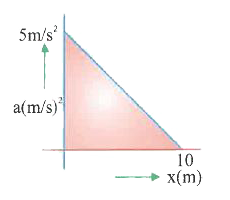A particle of mass 10 kg is moving in a straight line. If its displacement, x with time tis given by x=(t3−2t−10)m then the force acting on it at the end of 4 seconds is
24N
240N
300N
1200N
The correct Answer is:B
To solve the problem step by step, we need to find the force acting on a particle of mass 10 kg, given its displacement as a function of time. The displacement is given by the equation:
x(t)=t3−2t−10m
Step 1: Find the velocity of the particle
The velocity v is the first derivative of displacement x with respect to time t.
v(t)=dxdt=ddt(t3−2t−10)
Calculating the derivative:
v(t)=3t2−2
Step 2: Find the acceleration of the particle
The acceleration a is the derivative of velocity v with respect to time t.
a(t)=dvdt=ddt(3t2−2)
Calculating the derivative:
a(t)=6t
Step 3: Calculate the acceleration at t=4 seconds
Now, we substitute t=4 seconds into the acceleration equation:
a(4)=6×4=24m/s2
Step 4: Calculate the force acting on the particle
Using Newton's second law, the force F is given by:
F=m⋅a
Where m=10kg and a=24m/s2:
F=10kg×24m/s2=240N
Final Answer
The force acting on the particle at the end of 4 seconds is:
240N
---
The velocity v is the first derivative of displacement x with respect to time t.
The acceleration a is the derivative of velocity v with respect to time t.
Now, we substitute t=4 seconds into the acceleration equation:
Using Newton's second law, the force F is given by:
The force acting on the particle at the end of 4 seconds is:
Topper's Solved these Questions
- LAWS OF MOTIONBook:DISHA PUBLICATIONChapter:LAWS OF MOTIONExercise:Exercise-1: Concept Builder (Topicwise) (Topic 2: Momentum, Law of Conservation of Momentum and Impulse)
Explore 15 Videos
- LAWS OF MOTIONBook:DISHA PUBLICATIONChapter:LAWS OF MOTIONExercise:Exercise-1: Concept Builder (Topicwise) (Topic 3: Equilibrium of Forces, Motion of Connected Bodies and Pulley )
Explore 12 Videos
- LAWS OF MOTIONBook:DISHA PUBLICATIONChapter:LAWS OF MOTIONExercise:Exercise-2 : Concept Applicator
Explore 30 Videos
- JEE MAINS- 2019 (HELD ON :9TH APRIL 2019 (SHIFT-I))Book:DISHA PUBLICATIONChapter:JEE MAINS- 2019 (HELD ON :9TH APRIL 2019 (SHIFT-I))Exercise:QUESTIONS
Explore 30 Videos
- MAGNETISM AND MATTERBook:DISHA PUBLICATIONChapter:MAGNETISM AND MATTERExercise:EXERCISE-2:CONCEPT APPLICATOR
Explore 31 Videos
Similar Questions
A particle of mass 10 kg is moving in a straight line. If its displacement, x with time t is given by x=(at3+bt+c)m, the force acting on it at the end of 4 s is 240 N. Its displacement at t=0 is -10 m and its velocity at t=0 is -2 m/s. Here, values of a, b, c and acceleration are in the proper SI units :

View SolutionA particle is moving in a straight line. Its displacement at any instant t is given by x=10t+15t3, where x is in meters and t is in seconds. Find
(i) the average acceleration in the intervasl t = 0 to t = 2s and
(ii) instantaneous acceleration at t = 2 s.
View Solution
Knowledge Check
A body of mass 5 kg is moving in a straight line. The relation between its displacement and time t is given by x=(t3−2t−10) metre. What is the force acting onit at the end of second?
A150 NB120NC100ND80NA particle is moving in a straight line. Its displacement at time t is given by s(Inm)=4t2+2t, then its velocity and acceleration at time t=12 second are
A−2m/s,−8m/s2B2m/s,6m/s2C−2m/s,8m/s2D2m/s,8m/s2A point moves in a straight line so its displacement x metre at time t second is given by x2=1+t2. Its acceleration in ms−2 at time t second is .
A1x3B−1x3C1x−t2x3D1x−1x2
The position (x) of a particle of mass 2 kg moving along x-axis at time t is given by x=(2t3) metre. Find the work done by force acting on it in time interval t=0 to t=2 is :-
View SolutionA particle is moving in a straight line such that its distance at any time t is given by
x=t44−2t3+4t2+7. Then
View SolutionThe displacement of a particle of mass 2kg moving in a straight line varies with times as x=(2t3+2)m. Impulse of the force acting on the particle over a time interval between t = 0 and t = 1 s is
View SolutionFor a particle moving in a straight line, the displacement of the particle at time t is given by
S=t3−6t2+3t+7
What is the velocity of the particle when its acceleration is zero?
View SolutionA particle of mass 1 kg is moving in straight line and its acceleration v/s displacement graph is shown in figure. Work done by the force during x = 0 to x = 10 m is

View Solution

